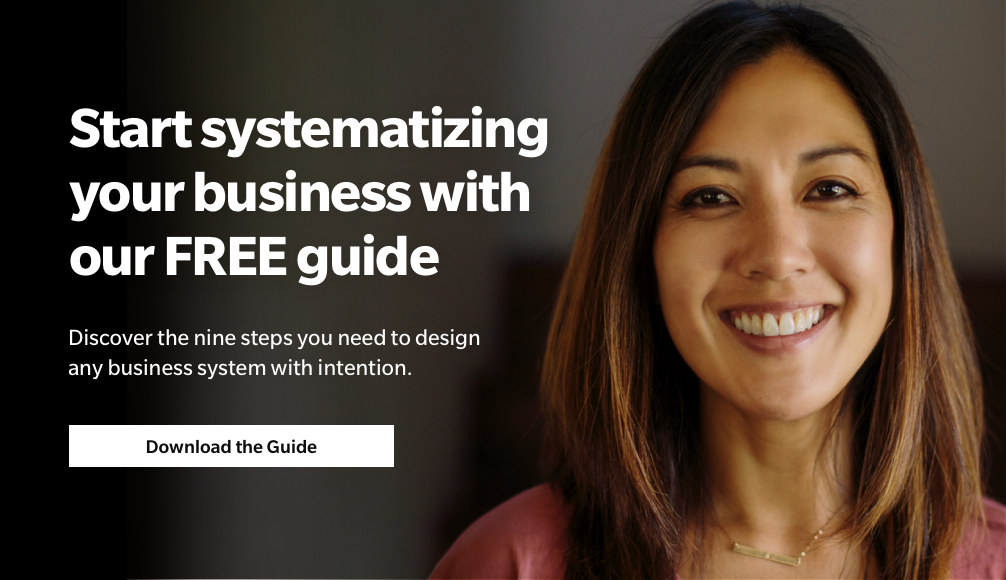You might have heard this joke before: How do you eat an elephant? One bite at a time, of course! You might’ve also heard that owning a business is like eating an elephant—there’s just too much to do. You have clients to take care of, sales calls to make. You need to call the newspaper about that ad, make sure the bills get paid. And somehow—in the midst of all that—you have to get your employees to show up to work on time and do their jobs.
It’s too much for any one person to manage. And when you add in the prospect of somehow finding more time to sit down and develop the systems you know you need to manage it all, you wonder how anyone is ever able to get their business running smoothly—never mind finding the time to actually grow it.
And you won’t find the time to do it all—not if your focus is on how to do it. No matter how many times you release your arrow of good intentions, you’ll never hit the target if you’re aiming somewhere else. If you want to achieve consistent, predictable results, you have to take careful aim every time—and know what you’re aiming at.
Identify your elephant
The question you should really be asking isn’t how to eat an elephant—it’s what is the elephant? You have to identify the elephant first, then focus on developing a system to prioritize where you’re going to start.
You need a vision of what your business will look like after the elephant has been eaten. Without that vision, nothing you do in your business will make much of a difference. You may make some small changes, and you may occasionally see those changes bring about good results. But without the vision, your business will never truly be great. You have to stop focusing on the work and start focusing on the results.
Define and communicate your vision
As the business owner, your most important job is the development of your vision. That’s it. It’s not taking care of your clients, it’s not making sales calls, it’s not advertising your services, it’s not paying the bills—it’s not even managing your employees. Your job, your most important role, is defining what your business will look like when you’ve achieved your vision and effectively communicating that to your staff.
Think of it this way: If your company makes widgets, your focus isn’t how you’re going to produce a widget. It’s not about how you’re going to deliver your widget to your customer. It’s not about how your employees are going to help you make your widgets the best on the market. Your focus is the what—the vision. What is the widget going to do for your client? What will it look like? What is your promise to your customers? What will your employees feel like coming to work every day? What will set your widget company apart from every other widget company out there? Focus on the results, not the work.
You might be thinking, “I have a vision for my business, but my employees aren’t helping me achieve it!” If that’s the case, it’s because you haven’t effectively communicated that vision to them. They can’t help you hit the target if they don’t know where the target is or what it looks like.
Approach your elephant strategically
Once you’ve identified your elephant, you need a strategy to determine which bite to take first. With a defined strategy, you can choose where to start. But to do that, you need a system for prioritizing. Without that system, you’ll get stuck in reactive mode. You’ll develop whatever system seems most important (or whatever problem seems most frustrating) right at that moment. And while you’re putting together a system to deal with that frustration, five more problems will pop up, each seemingly more important, more vital to the survival of your business than the one you’ve started working on. If you really want to make progress, you have to break this cycle of reactivity and develop a system that lets you prioritize proactively.
Break you business down into systems
Whether you know it or not, your business already has seven systems in place: Leadership, Management, Finance, Marketing, Lead Generation, Lead Conversion and Customer Fulfillment. If your business is the elephant, you’ll start to see how to take smaller bites when you break the business down into these Seven Essential Systems.
Focus your attention first on the system that’s most in need of your attention. Spend an hour thinking about all the systems and subsystems you’ll need to get that essential system operating at its best, and write them down. Repeat this process regularly, starting each time with the question: “Which system needs the most attention in my business this week?”
Take small bites out of your elephant. Take the right bites. But most importantly, determine what your elephant will look like when you’ve eaten the whole thing. Stay focused on the results, not the work—and before you know it, the business you’ve been envisioning will be a reality.
Ready to eat your elephant, but still not sure where to start? Take our free business assessment to see where your systems stand, or reach out to us for help.




Comments